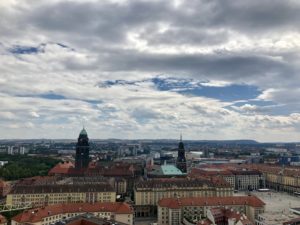Die Kontrovers – Controversy
In August of 1945, the United States dropped the first atomic bomb on Hiroshima, Japan, killing approximately 66,000 people and injuring approximately 66,000 more individuals. Three days later, another atomic bomb was dropped on Nagasaki, killing and injuring another estimated 64,000 people. Nearly 75 years later, the decision of the United States to use atomic weapons against Japan remains controversial. Since 1945, advocates of the use of atomic weapons maintained that the dropping of these bombs on Japan brought the Asian Theatre of WWII more quickly to an end. Alternatively, those against the use of atomic weapons argued that this decision was inhumane and unnecessary.
You may wonder why I am discussing Japan and the Asian Theatre of World War II in a blog about my travels and experiences in Germany. However, there is a connection. In Dresden, a different undertaking of the Allies during WWII remains controversial: die Luftangriffe auf Dresden, the Bombing of Dresden.
In 1945, five years after the conflict in Europe began, the war had completely absorbed the economies and populations of more than 50 independent nations. By February of the same year – as the last months of European conflict dragged on – Soviet forces had finally halted the German Army in Eastern Prussia as the combined Allied forces blocked the German Army’s invasion into the Ardennes forest in Belgium. Less than three months later, the European Theatre of WWII ended with the unconditional surrender of the German Army.
Despite the state of German forces in February 1945, the United States and Great Britain dropped more than 4,000 tons of explosives on the city of Dresden over a period of three days. As a result, over 75,000 dwelling places were destroyed. Though a few historic buildings – such as the Zwinger and Frauenkirche – were carefully rebuilt, most of the city was rebuilt with modern architectural style, leaving the city which had once been known as “the Florence of the Elbe” a very different place.

As with the events at Hiroshima and Nagasaki, many now question whether such destruction was truly necessary at a time when Germany had already begun to fall into the hands of defeat. Allied forces argued that the attack was needed to disrupt important lines of communication which may have hindered the Soviet offensive in the east. As the seventh largest city in Germany at the time, it has also been argued that bombing Dresden may have been important to destroying German munitions. However, the evidence supporting this claim is somewhat lacking, leading many to question how strategically and militarily important Dresden truly was.
Three-quarters of a century later, the effects of this bombing campaign can still be seen today. After taking a tour of the Frauenkirche, and climbing to the top to get a beautiful view of Dresden, the impact of war upon the city was easily recognizable. Even in the Altstadt portion of the city, most buildings have clearly been built within the last century. Those historic buildings, which have been rebuilt to represent the baroque style with which they had first been imagined, clearly show the marks of destruction. Original stone, charred from the fire which blazed after the attacks, sits in the walls of these buildings, often surrounded by new, untarnished stone.


Despite this destruction and forced reconstruction, Dresden maintains a great amount of culture and historical value. In fact, from 2004 until the construction of the Waldschloesschen Bridge in 2009, Dresden held UNESCO World Heritage status for its riverscape along the Elbe. As a result, Dresden has provided an extremely interesting and meaningful place for me to study German language and culture.

Mit Herzlichen Grüßen!